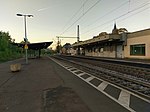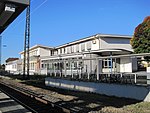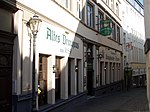Lahnstein

Lahnstein (German pronunciation: [ˈlaːnʃtaɪn]) is a verband-free town of Rhein-Lahn-Kreis in Rhineland-Palatinate, Germany. It is situated at the confluence of the Lahn with the Rhine, approximately 6 kilometres (3.7 mi) south of Koblenz. Lahnstein was created in 1969 by the merger of the previously independent towns of Oberlahnstein (or Upper Lahnstein) on the south side of the Lahn (above the river mouth) and Niederlahnstein on the north side (below the river mouth). In 2020, it had a population of 18,030. Situated on the heights of the foothills of the Westerwald and the Taunus, Lahnstein is considered a fresh-air spa city with spa facilities and thermal baths. It is also the seat of a district court. In religious affairs, it is assigned to the Roman Catholic Diocese of Limburg and to the Evangelical Church in Hesse and Nassau. Because of its strategic importance on the Rhine, Lahnstein was heavily fortified. Many old gates and towers still demonstrate its importance in the Middle Ages. Lahneck Castle, situated high above Oberlahnstein, was built between 1240 and 1245 and served as a residence of the Archbishop-Electors of Mainz. Other sights in Lahnstein include Martinsburg Castle on the bank of the Rhine in Oberlahnstein, the Allerheiligenbergkapelle, St. John's Abbey (Johanneskloster), and the Rheinsteig hiking trail.
Excerpt from the Wikipedia article Lahnstein (License: CC BY-SA 3.0, Authors, Images).Lahnstein
Frühmesserstraße,
Geographical coordinates (GPS) Address Nearby Places Show on map
Geographical coordinates (GPS)
| Latitude | Longitude |
|---|---|
| N 50.301111111111 ° | E 7.6055555555556 ° |
Address
Frühmesserstraße 5
56112 , Oberlahnstein
Rhineland-Palatinate, Germany
Open on Google Maps







